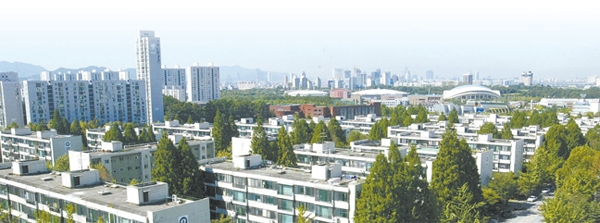National Planning Conference will be held in San Francisco, 13-16, April, 2019.
See APA's announcement at
https://www.youtube.com/watch?time_continue=58&v=FzXKEKNLr2Y
My viewpoints will be:
1. Planning profession - American system
2. How technologies impact on planning - smart cities, planning management, planning practice
3. Fundamental challenges and innovations in planning profession
These focus reflects my interests on:
1. Changing nature of planning and planner
2. Emerging technologies and future cities
3. The future of Korea planning education and practice

The term sustainability has 'become like a rubber band that can be stretched almost at will in many directions'. Photograph: Will Crocker/Getty Images
For 25 years, sustainable development has been held up as the solution to the world's problems. But instead we have had ever more pollution, biodiversity loss and climate change. The concept of sustainability has been abused like few other terms in history. It is time to think not just about sustaining the world's badly damaged ecosystems and human communities, but about regenerating them instead.
Sustainable development (SD) has been a global orthodoxy ever since it was agreed as a guiding principle for collective human action in the runup to the 1992 Rio Earth Summit. The official definition is well known: "Sustainable development … meets the needs of the present without compromising the ability of future generations to meet their own needs." Effectively, it was a marriage of convenience to facilitate north-south collaboration on enhancing human livelihoods while also halting humanity's deteriorating relationship with its host planet.
SD is a concept to which few people would object; most of us would agree that we should not live as if there were no tomorrow. But the term has become like a rubber band that can be stretched almost at will in many directions.
In the past 25 years, only lip-service has been paid to SD, particularly around the use of fossil fuels. During that time, all economic and urban development across the world has been driven by the ever greater use of coal, oil and gas. And yet, the very use of fossil fuels is inherently unsustainable as they are a finite resource, and their combustion is the predominant contributor to climate change.
In any case, how long is sustainable: 10 years, 100 years, 1,000 years? And who and what should be sustainable: households, cities, whole nations, the world economy? And who should benefit: current generations or all humans who will ever be alive? And where is the critique of the current economic system: can SD really occur under the rules of capitalism,where the refusal to put a price on nature's services and on ecological and social externalities is a systemic problem?
In my view, we need to start thinking of regenerative rather than just sustainable development. We urgently need to take specific measures to help regenerate soils, forests and watercourses rather than just allowing them to be sustained in an increasingly degraded condition as we have done for many years. We have the knowledge and the technologies to make renewable energy our main energy sources. And we urgently need to regenerate local communities and economies that have fallen by the wayside as economic globalisation has become a dominant force.
It follows that only a systemic, rather than a vague compromise approach to future development will suffice, starting with the realisation that development cannot be at the expense of the health of the world's ecosystems and that their protection and continuous regeneration must be a guiding principle for human action. It is high time that these realisations were embedded in the teaching of economic theory at universities and business schools all over the world.
An acute state of emergency exists on Earth, imperilling its climate, its life support systems and the lives of billions of people. Could we create a better conceptual framework to assure a plausible future for people and planet?
The concept of regenerative development aims to fill this gap: it means that we need to develop comprehensive rules for an environmentally enhancing, restorative relationship between humanity and the ecosystems from which we draw resources for our sustenance.
In my own work, I have concentrated primarily on the metabolism of cities, examining urban resource consumption and waste disposal patterns. In an urbanising world, the bulk of human impacts on the biosphere are from urban production and consumption. Cities are the primary location of national economic activities. Modern cities are also defined by their dependence on the use of energy, with the bulk of the world's fossil being burned to power urban systems. Urban energy consumption and global climate change are intimately connected.
Much damage has been done to the world's ecosystems already, and urgent solutions need to be found to reverse it. The time has come for cities to take specific measures to help regenerate soils, forests and watercourses rather than just sustaining them in a degraded condition, and to make renewable energy their main sources of energy supply.
Creating a circular rather than a linear urban metabolism – giving plant nutrients back to nature, storing carbon in soils and forests, reviving urban agriculture, powering human settlements efficiently by renewable energy, reconnecting cities to the regional hinterland – these measures are the basis for creating viable new urban economies which are so badly needed in this time of financial and economic crisis.
Regenerative development is as much about an honest give-and-take between humans and nature as about reviving human communities at the local level. It is a concept that matches closely with the ideas of EF Schumacher, author of Small is Beautiful, in whose name the upcoming Schumacher Lectures are being held.
Herbert Girardet will be speaking at the Schumacher Lectures at City Hall in Bristol on 15 June. The lectures aim to map out steps towards regenerative development.
From The Guardian http://www.theguardian.com/sustainable-business/blog/sustainability-unhelpful-think-regeneration?INTCMP=SRCH
Sustainable development (SD) has been a global orthodoxy ever since it was agreed as a guiding principle for collective human action in the runup to the 1992 Rio Earth Summit. The official definition is well known: "Sustainable development … meets the needs of the present without compromising the ability of future generations to meet their own needs." Effectively, it was a marriage of convenience to facilitate north-south collaboration on enhancing human livelihoods while also halting humanity's deteriorating relationship with its host planet.
SD is a concept to which few people would object; most of us would agree that we should not live as if there were no tomorrow. But the term has become like a rubber band that can be stretched almost at will in many directions.
In the past 25 years, only lip-service has been paid to SD, particularly around the use of fossil fuels. During that time, all economic and urban development across the world has been driven by the ever greater use of coal, oil and gas. And yet, the very use of fossil fuels is inherently unsustainable as they are a finite resource, and their combustion is the predominant contributor to climate change.
In any case, how long is sustainable: 10 years, 100 years, 1,000 years? And who and what should be sustainable: households, cities, whole nations, the world economy? And who should benefit: current generations or all humans who will ever be alive? And where is the critique of the current economic system: can SD really occur under the rules of capitalism,where the refusal to put a price on nature's services and on ecological and social externalities is a systemic problem?
In my view, we need to start thinking of regenerative rather than just sustainable development. We urgently need to take specific measures to help regenerate soils, forests and watercourses rather than just allowing them to be sustained in an increasingly degraded condition as we have done for many years. We have the knowledge and the technologies to make renewable energy our main energy sources. And we urgently need to regenerate local communities and economies that have fallen by the wayside as economic globalisation has become a dominant force.
It follows that only a systemic, rather than a vague compromise approach to future development will suffice, starting with the realisation that development cannot be at the expense of the health of the world's ecosystems and that their protection and continuous regeneration must be a guiding principle for human action. It is high time that these realisations were embedded in the teaching of economic theory at universities and business schools all over the world.
An acute state of emergency exists on Earth, imperilling its climate, its life support systems and the lives of billions of people. Could we create a better conceptual framework to assure a plausible future for people and planet?
The concept of regenerative development aims to fill this gap: it means that we need to develop comprehensive rules for an environmentally enhancing, restorative relationship between humanity and the ecosystems from which we draw resources for our sustenance.
In my own work, I have concentrated primarily on the metabolism of cities, examining urban resource consumption and waste disposal patterns. In an urbanising world, the bulk of human impacts on the biosphere are from urban production and consumption. Cities are the primary location of national economic activities. Modern cities are also defined by their dependence on the use of energy, with the bulk of the world's fossil being burned to power urban systems. Urban energy consumption and global climate change are intimately connected.
Much damage has been done to the world's ecosystems already, and urgent solutions need to be found to reverse it. The time has come for cities to take specific measures to help regenerate soils, forests and watercourses rather than just sustaining them in a degraded condition, and to make renewable energy their main sources of energy supply.
Creating a circular rather than a linear urban metabolism – giving plant nutrients back to nature, storing carbon in soils and forests, reviving urban agriculture, powering human settlements efficiently by renewable energy, reconnecting cities to the regional hinterland – these measures are the basis for creating viable new urban economies which are so badly needed in this time of financial and economic crisis.
Regenerative development is as much about an honest give-and-take between humans and nature as about reviving human communities at the local level. It is a concept that matches closely with the ideas of EF Schumacher, author of Small is Beautiful, in whose name the upcoming Schumacher Lectures are being held.
Herbert Girardet will be speaking at the Schumacher Lectures at City Hall in Bristol on 15 June. The lectures aim to map out steps towards regenerative development.
From The Guardian http://www.theguardian.com/sustainable-business/blog/sustainability-unhelpful-think-regeneration?INTCMP=SRCH

.JPG)




